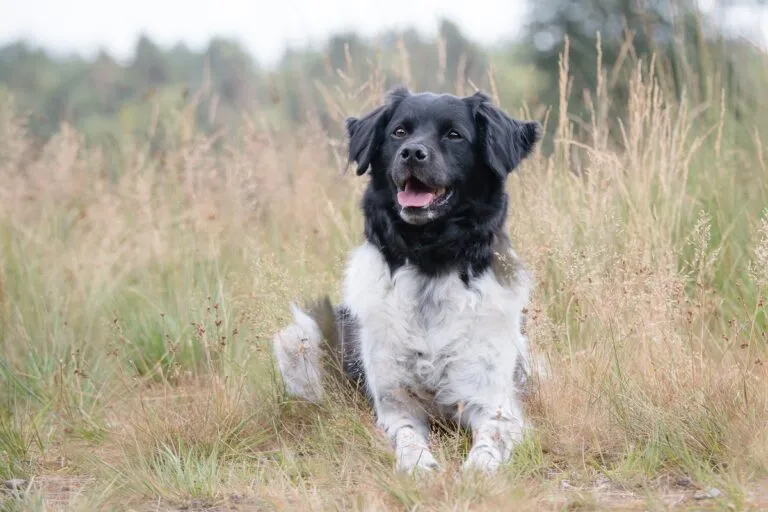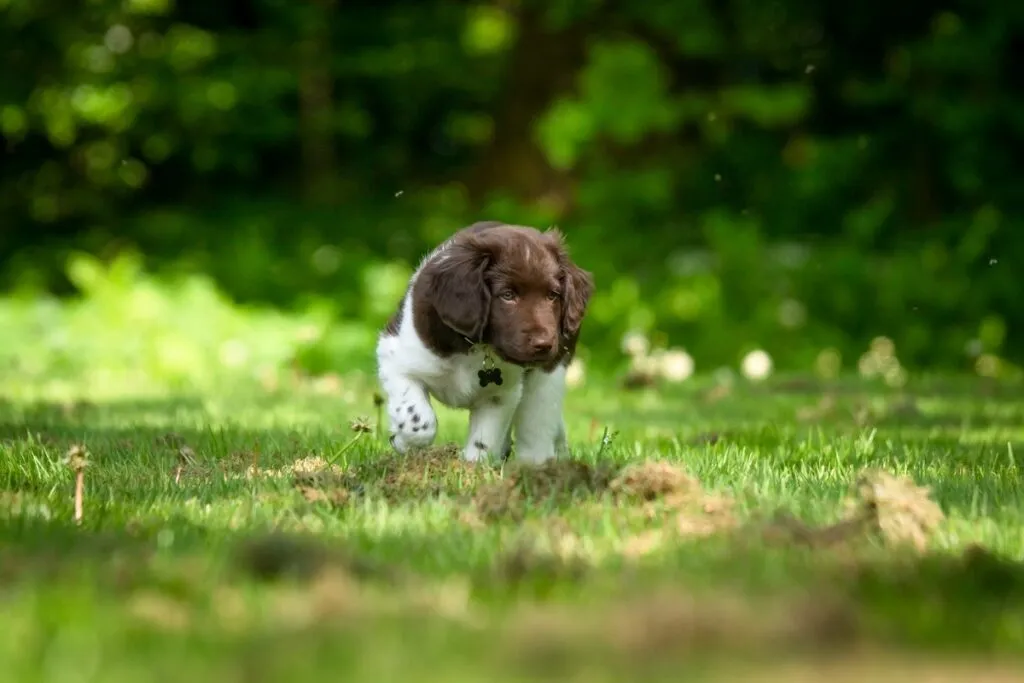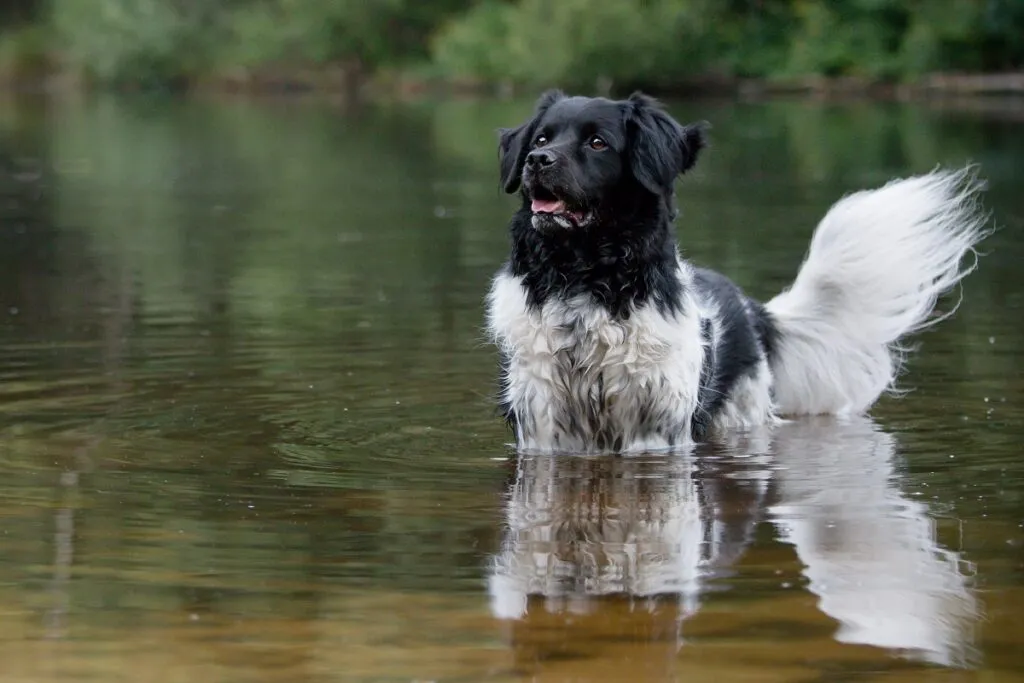Medium Size Poodle
The Stabyhoun is a handsome and alert dog from the Dutch region of Friesland. At home, it's valued as a dependable farm guardian and a pointing dog for hunting. Want to know more about this rare four-legged friend? Read on to discover more about the Stabyhoun.

© Charlotte / stock.adobe.com
The not-so-common Stabyhoun has its roots in Friesland.
At first glance, the Stabyhoun bears a strong resemblance to the Kleiner Münsterländer. It can weigh up to 27kg, presenting a well-balanced physique. Ideally, the breed should be neither excessively muscular nor too slender.
In a positive light, the Stabyhoun is wonderfully average: picturing how a child might draw a dog comes to mind.
Medium in size with horizontally set, round eyes, the Stabyhoun’s gaze is always alert yet exudes a friendly overall expression. Its floppy ears form a soft triangle and its slightly curved tail reaches down to the hock and is set quite low.
The Stabyhoun’s trademark is its medium-length fur. If you find yourself constantly wanting to run your fingers through its slightly wavy hair, you’re not alone!
It’s irresistibly soft and silky. The coat mostly varies between black and white or black and brown shades, with longer fur on the torso than the legs.
 © Polarpx / stock.adobe.com
© Polarpx / stock.adobe.com
The independent Stabyhoun is content to amuse itself in its surroundings during the day. It naturally wants to guard its property and patrol its boundaries. It considers its home sacred and its duty to protect against any dangers.
The Stabyhoun is inherently peaceful towards humans. It doesn’t bite or become aggressive. However, it can often appear reserved or even shy around unfamiliar people.
Winning its trust takes time, but once the dog becomes accustomed to someone, it becomes very trusting and friendly.
One thing should be noted: the Stabyhoun isn’t a barker by nature. However, it will regularly sound the alarm when something approaches its home. Visitors, the postman, or even returning family members should expect a vocal welcome.
If you keep the Stabyhoun in a flat against recommendations, noise can become an issue – think of noise pollution. But since the Stabyhoun is intelligent and trainable, such issues can be addressed at a dog training school.
The Stabyhoun excels in dummy training, hunting, and tracking work, and is well-suited for competition dog sports. This breed’s natural obedience and teachability make it a great candidate for these disciplines.
Stabyhouns relish learning new things and pleasing their owners. They rapidly pick up new skills with their intelligence and high level of attention and can smoothly execute learned behaviours.
Various dog toys can keep the Stabyhoun stimulated, even if it isn’t overly playful. Variety keeps their mind sharp and their temperament balanced.
Stubborn streak Stabyhouns usually follow commands promptly. However, some owners report a certain stubbornness.
The Stabyhoun thrives on guarding property and having plenty of free roam as a hunting dog. A home with some land is the ideal setting for this breed.
Though very adaptable, when living in an apartment, the Stabyhoun demands even more physical and mental stimulation.
Compensate for the limited space with long walks and nature trails. Without this, the dissatisfied dog might become rebellious due to sheer boredom!
Novice dog owners can find joy with a Stabyhoun due to its amiable and easily directed nature. However, prepare for a touch of independence and a strong work ethic.
The breed generally gets along well with other dogs. However, it may eagerly chase cats up the nearest tree. It’s gentle and loving with the smallest of family members, and children can safely play and cuddle with this farm dog.
Remember these tips for Stabyhoun care:
Quality dog food is key for a long and happy canine life – Stabyhouns are not fussy and enjoy both dry and wet food. They have sturdy stomachs and handle various foods well. However, this doesn’t mean feeding them leftovers is permissible!
Barfing (biologically appropriate raw food) can suit the Stabyhoun, as it emulates the diet of wild canines. However, this approach requires significant effort from the owner. To successfully implement raw feeding:
The Stabyhoun boasts long fur that’s considered self-cleaning. Dry dirt and mud tend to fall off on their own, posing little hassle.
Still, a good brush now and again is beneficial. Such grooming sessions can strengthen the bond between pet and owner and be fun when done playfully.
The Stabyhoun has a robust constitution with no breed-specific illnesses. Without sufficient exercise, it might get a tad plump, but this is easily remedied with controlled feeding and walks, regardless of the weather. Its fur is resilient to both cold and wet conditions.
With proper physical activity, feeding, and enough mental stimulation, the dog can live for approx. 14 years – ample time for wonderful experiences with your faithful companion!
 © Charlotte / stock.adobe.com
© Charlotte / stock.adobe.com
The breed has likely been in the Dutch region of Friesland for quite some time. The actual origins are a topic of speculation. It’s hypothesized that the breed’s forebears may have been Spanish or French Spaniels imported to the Netherlands.
In the first half of the 20th century, the Wetterhoun was crossed in, possibly lending the Stabyhoun its weather-resistant fur. Since 1960, the Stabyhoun has been officially recognised by the FCI.
Stabyhound or Stabijhoun? Stabijhoun is the Dutch variant of the breed’s name.
The Stabyhoun isn’t widely spread, its breeding mainly concentrated in its native Netherlands. You’ll likely need to travel to the Netherlands to purchase a Stabyhoun puppy.
Expect to wait a bit for an available puppy since the market is quite small.
In the Netherlands, prices for Stabyhoun puppies vary from budget hobby breeders to more expensive professionals, ranging between €500 and €1,000.
Tip: Always ensure a clean breeding line and personally visit the breeding facility.
The Stabyhoun is a well-rounded dog that faithfully guards home and farm. Its fluffy fur and all-round character are major advantages. It’s an uncomplicated companion for both active individuals and families.
The only patience required is in sourcing a puppy, but the commitment is worthwhile for a life expectancy of 14 years.
| Distinguishing Features: | The Stabyhoun is a loyal, friendly pointer from the Netherlands, notable for its calm and vigilant nature. Its fur is especially weather-resistant. |
| Character: | vigilant, teachable, friendly |
| Height at Withers: | Male: 50 – 53 cm Female: 48 – 51 cm |
| Weight: | Male: 22 – 27 kg Female: 18 – 23 kg |
| Coat: | long, slight waves, pied in black, brown with white markings |
| Coat Care: | not too demanding, regular brushing is beneficial |
| Exercise: | enjoys movement, requires regular, extensive walks |
| Suitable for Beginners: | suitable for beginners with proper training and sufficient activity |
| Barking: | barks at visitors |
| Lifespan: | 13 – 14 years |
| Typical Illnesses: | very robust health, no known breed-specific diseases |
| Price: | €500 – €1,000 |
| FCI Group: | Group 7: Pointing Dogs |
| Origin: | Friesland, Netherlands |
Here are some purchase proposals curated by the zooplus editorial team
The products featured have been carefully selected by our editorial staff and are available at the zooplus online pet shop. The selection does not constitute advertising for the mentioned brands.
Fans of the Bearded Collie agree that those who aren't familiar with this dog breed simply have to get acquainted with it. And those who have experienced how a Bearded Collie bolts across meadows with its flowing fur, how it rolls around full of energy and joy and how it attentively and observantly takes into account its owners wishes become simply addicted to this original dog breed and its unique charm.
The Goldendoodle isn't a breed, but a pairing between Golden Retrievers and Medium or Standard Poodles. Marketed as a low-maintenance dog for allergy sufferers, this hybrid is enjoying increasing popularity amongst dog lovers, similar to the Labradoodle.